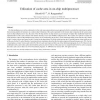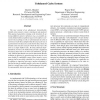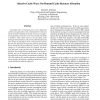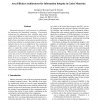ISCA
1998
IEEE
14 years 4 months ago
1998
IEEE
Modern cache designs exploit spatial locality by fetching large blocks of data called cache lines on a cache miss. Subsequent references to words within the same cache line result...
ISCA
1998
IEEE
14 years 4 months ago
1998
IEEE
In the past decade. there has been much literature describing various cache organizatrons that exploit general programming idiosyncrasies to obtain maxrmum hit rate (the probabili...
ISHPC
1999
Springer
14 years 4 months ago
1999
Springer
On-chip multiprocessor can be an alternative to the wide-issue superscalar processor approach which is currently the mainstream to exploit the increasing number of transistors on ...
ICS
1999
Tsinghua U.
14 years 4 months ago
1999
Tsinghua U.
As the gap between memory and processor speeds continues to widen, cache efficiency is an increasingly important component of processor performance. Compiler techniques have been...
HIPC
1999
Springer
14 years 4 months ago
1999
Springer
We describe a radically new cache architecture and demonstrate that it offers a huge reduction in cache cost, size and power consumption whilst maintaining performance on a wide ra...
WETICE
1999
IEEE
14 years 4 months ago
1999
IEEE
Our Workgroup Cache system operates as a virtual intranet, introducing a shared cache to members of the same workgroup. Users may be members of multiple workgroups at the same tim...
EUROPAR
1999
Springer
14 years 4 months ago
1999
Springer
Processor cycle time continues to decrease faster than main memory access times, placing higher demands on cache memory hierarchy performance. To meet these demands, conventional ...
MTDT
1999
IEEE
14 years 4 months ago
1999
IEEE
The new concept of an unbalanced, hierarchicallydivided cache memory system is introduced and analyzed. This approach generalizes existing cache structures by allowing different m...
MICRO
1999
IEEE
14 years 4 months ago
1999
IEEE
Increasing levels of microprocessor power dissipation call for new approaches at the architectural level that save energy by better matching of on-chip resources to application re...
ISCA
1999
IEEE
14 years 4 months ago
1999
IEEE
Information integrity in cache memories is a fundamental requirement for dependable computing. Conventional architectures for enhancing cache reliability using check codes make it...






